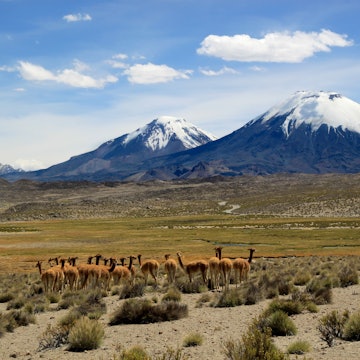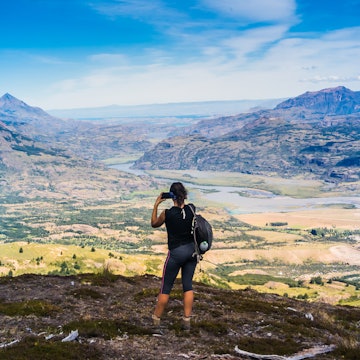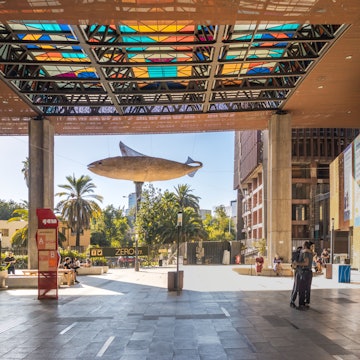

Plan your travels around Patagonia with our top tips on transportation
In huge Patagonia, there are plenty of different transportation options.
The region’s towns are well connected by a network of buses, with frequent flights to larger towns from the capital cities of Chile and Argentina. Chile’s long coastline, meanwhile, is served by an array of watercraft. For greatest flexibility, you can choose to explore Patagonia on wheels of your own, whether two or four.
It’s crucial to remember that Patagonia is a vast, sparsely populated region of mountains, glaciers and pampas (grasslands) at the end of the world. Any trip here presents logistical challenges and requires careful planning. Since the region’s attractions are very spread out, and since where and when you go largely depends on what you want to do, here’s everything you need to know about getting around Patagonia by air, bus, boat, bicycle and car.
Traveling by air can be a time-saver
Local flights can be a real time-saver when you have to cover considerable distances. Chile’s domestic routes are covered by Sky Airlines and JetSmart, with Sky Airlines offering the best one-way prices; Argentina is covered by Aerolíneas Argentinas, Andes Líneas Aéreas and LADE. LATAM operates flights in both countries.
Main flight routes
In Chile, there are direct flights from Santiago and Puerto Montt south to Coyhaique (the largest town in Chile’s northern Patagonia), and Punta Arenas and Puerto Natales in southern Patagonia. Punta Arenas offers short hops to Porvenir (Tierra del Fuego) as well as flights to Puerto Williams, Chile’s (and the world’s) southernmost settlement. Buenos Aires in Argentina is well connected to the popular Patagonian destinations of El Calafate, Esquel and Trelew, as well as Ushuaia in Tierra del Fuego, among others. There are no cross-border intra-Patagonian flights.
Along Chile’s Carretera Austral, Aerocord’s tiny, weather-dependent Cessnas and Piper Navajo planes connect Puerto Montt to Chaitén and Melinka.

Cycling is extremely fun but very challenging
Pedaling your way around Patagonia is a serious undertaking – which only seems to inspire two-wheeled warriors intent on tackling Chile’s iconic Carretera Austral or Argentina’s Ruta 40. Any cyclist will have to be prepared for challenging climatic conditions: fierce winds (particularly in southern Patagonia and in the Argentinean Pampas), and rain at any time of year (particularly in wet Aysén, in northern Chilean Patagonia). The good news is, given that Patagonia’s motor traffic is very light outside towns, you’ll often have the roads largely to yourself. If you take your bicycle on boats and ferries, you have to pay a small fee. Buses will usually stow bikes in the luggage compartment.
Cycling tips
A touring bike with good tires and a repair kit are essential, as is a sturdy all-season tent, since distances between towns are often considerable and you’ll find yourself camping wild. Punctures are not uncommon on the unpaved roads, and while there are bicycle repair shops in most towns, along the Carretera Austral – where you’re likely to need one most – they can only be found in Coyhaique.
Southern Chile offers epic opportunities for boat travel
With its long, convoluted coastline and vast glacial lakes, southern Chile offers epic opportunities for boat travel – though ferry travel is limited outside of high season and weather-dependent year-round. Book tickets (including for car ferries along the Carretera Austral) well in advance for travel during the peak December to February months, or turn up at least an hour before departure for rides that aren’t bookable ahead.
Travel by boat in Argentinian Patagonia is very limited, unless you count taking a boat across Lago del Desierto near El Chaltén in order to hike to the Chilean border post of Candelario Mancilla, and then another boat across Lago San Martín/O’Higgins to Chile’s Villa O’Higgins.
If you take a bus from El Calafate to Ushuaia in Tierra del Fuego, that automatically involves crossing the border into Chile and a car ferry across the Magellan Strait before the bus ducks back into Argentinian territory.
Try one of these unique boat experiences
If you have a few days to spare, one unmissable travel experience involves taking the four-day Navimag ferry from Puerto Montt in Chile’s Lake District to Puerto Natales in southern Patagonia – a journey that takes you through a maze of tiny islands, fjords and glaciers, with dolphin and whale sightings en route if you’re lucky... and fog and rough seas if you’re not. Since Navimag is primarily a cargo ship, think of it as a basic cruise ship but with backpacker berths, tiny, basic cabins and cows.
In Ushuaia, there’s the option of crossing the Beagle Channel to Chile’s Isla Navarino (to reach Puerto Williams) in an inflatable Zodiac boat. This 30-minute crossing is weather-dependent and often delayed by high winds. Sometimes, you might be lulled into a false sense of security by the calm waters of Ushuaia’s bay, only to find the Zodiac bouncing on and being battered by house-sized waves farther out in the channel. So be prepared for greater excitement than you signed up for!

Take the bus for affordable long-distance journeys
Long-distance buses in Chile and Argentina are punctual, rank among the most comfortable in the world, and are relatively inexpensive. Most Chilean and Argentinian towns have a single large bus station, well-organized, with restrooms, left luggage, food kiosks and destinations and fares prominently displayed – though there can be exceptions. In Punta Arenas (Chile) and Ushuaia (Argentina), buses stop at the offices of their respective companies, so it takes some leg work to figure out which bus company you’ll need to get to your destination. Coyhaique (Chile) has a central bus terminal, though a number of small bus companies nevertheless operate from individual bus offices around town.
In Chile, the biggest bus companies are TurBus and Pullman, both of which operate in southern Patagonia; you can purchase tickets from their respective websites. Aysén, Chile’s northern Patagonia, is covered by small minibus companies with limited services and tickets may only be purchased from the bus offices. Argentine websites selling long-distance bus tickets include Omnilineas and Plataforma 10.
Note that long-distance buses traveling from southern Patagonia to Chilean destinations in the Lake District and farther north invariably cross the border into Argentina and back again but do not stop at Argentinian destinations. Likewise, buses from El Calafate and other destinations in Argentinian Patagonia bound for Ushuaia must pass through Chilean territory to do so.
Make bus reservations in advance and consider seasonal services
Buy your ticket well in advance for journeys during the holidays (Christmas, Easter, the months of January and February), and for Fridays and Sundays; otherwise, a few hours ahead generally suffices.
There are good bus connections between towns during peak and shoulder seasons (November through March) but far fewer services the rest of the year. This particularly affects travel along Argentina’s Ruta 40, where bus company Taqsa/Marga and private company Chalten Travel run services between Bariloche in the Lake District and various Patagonian destinations, and along Chile’s Carretera Austral, where minibuses to remote towns run on a limited basis even during high season.

Renting a car gives you the most flexibility
Patagonia’s roads are very lightly trafficked and incredibly scenic. Hiring a car gives you the most flexibility, and you’ll need your own wheels to get to remote national parks and attractions, particularly off Chile’s Carretera Austral. Hiring a 4WD is not necessary, but a car with high clearance is desirable for main routes and essential for exploring unpaved minor roads.
You’ll find major international rental companies at airports and around town in Punta Arenas and Coyhaique in Chile, and El Calafate and Ushuaia in Argentina. Shop around; local companies often charge less per day. To hire a car, a driver’s license from your home country usually suffices. One-way rentals can be difficult to arrange, and when they are one-way drop-off charges can be brutally steep. You have to purchase seguro obligatorio (minimum insurance); additional liability insurance is a good idea, since damage to tires and windscreens on unpaved roads is likely. To cross the border between Chile and Argentina, you’ll need special insurance.
Tips for driving remote routes
Driving Patagonia’s remoter routes – the legendary Ruta 40 and Carretera Austral – is less challenging than it used to be, but precautions still need to be taken:
There is no phone coverage outside of towns, so make sure you travel with a spare tire and other basic repair equipment – and know how to use it. Other drivers will stop to help in case of breakdown.
Fill up on gas at every available opportunity.
Carry supplies of food and water and a good sleeping bag.
If exploring Tierra del Fuego, you may need to carry spare canisters of fuel, since gas stations are very few and far between.
















